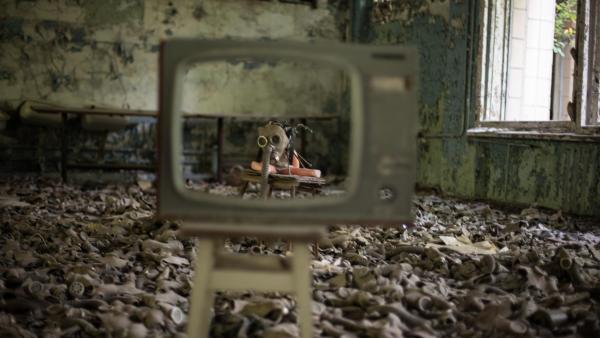The Russians have blamed Ukraine for launching attacks against their forces at the reactor site endangering the reactors; the Ukrainians have accused the Russians of deliberately putting the reactors at risk by stationing troops on the grounds. Russia has told the Ukrainian operators that the reactors now belong to Russia, the International Atomic Energy Agency has asked to visit the reactors to confirm they remain safe, and the media is filled with speculation about what might happen to the reactors and how that might affect Ukraine, Europe, and the world.
We’re not going to be able to untangle the politics here – but let’s discuss some of the scientific and technical concerns to see if we might be able to shed some light there. For background, you might want to refer to a discussion of how nuclear reactors operate and how they can fail.
Why are the reactors even operating in the middle of a war – why don’t the Ukrainians just shut them down?
It seems so reasonable, doesn’t it, to put a line in the reactor operating manual saying something like “If war breaks out, shut down the reactors” or “In case of shelling, hit the scram switch”? Unfortunately, life’s a little more complicated than this. The reactors at Zaporizhzhia provide as much as 20% of Ukraine’s electrical energy –5700 MW when all reactors operate at full power. This is a lot of energy – especially for a nation at war, and it’s not to be taken away lightly. Electrical energy powers more than just refrigerators, air conditioners, lights, and televisions – it also powers hospitals, air traffic control radars and computers, refrigeration plants, factories, water treatment plants and pumps, and so much more that undergirds society, and that helps to support the war effort. Electrical energy is a vital war-fighting resource and is likely one of the reasons Russia wanted to seize these plants – to deny this power to Ukraine and possibly to take it for themselves. Having said that, at present, only two of the six reactors are operating online. But with Russia now in control of the reactor site, the operators are likely not free to shut down the remaining reactors without Russia’s concurrence.
If so many reactors are shut down, why are we worried about them melting down?
Here’s the thing – fission creates energy by splitting (fissioning) uranium atoms, with every uranium atom that fissions are creating two smaller radioactive atoms (fission products). Even after the reactor shuts down, these fission products are decaying away and producing energy. The energy released from this decay is only a few percent of the reactor's energy. Suppose the reactor was producing 1000 MW when it shut down. In that case, the fission products will produce a few tens of MW of thermal energy(decay heat)…enough to cause even a shutdown reactor to heat up, damaging the fuel and even causing a meltdown. While decay heat drops with time, it can take months or even years to fall to the point where constant cooling is no longer needed. Until then, it’s necessary to keep circulating water past the fuel to keep it cool.
Don’t the reactors make their own electricity? Why do they need to bring in power from the grid?
Nuclear power stations make electricity – that’s why they’re built. And they’re certainly capable of powering the pumps that circulate coolant to keep the fuel cool (in this case, “cool” means between 500-600 degrees F – hotter than your oven). The problem is that even when shut down (and no longer producing electricity), a reactor still produces heat and needs to be cooled, so they still require electrical power to run the cooling pumps. The best way to do this is to draw electricity from the power grid; if that’s not available, reactor plants have emergency diesel generators that kick on automatically to power vital systems (e.g., emergency cooling, instrumentation, and so forth).
Diesels will keep things safe as long as they’re running properly…which means they need to be refueled from time to time. We saw this in Japan after the East Tohoku Earthquake. The earthquake knocked out parts of the Japanese electrical grid, causing the reactor operators to shut down the reactors; the emergency diesels started up and ran as designed…until the tsunami hit and overtopped the seawall and flooded the generators. It was only then that the core began to heat up and suffer damage.
So as long as the reactors are running and producing electricity, that energy can be used to power the cooling pumps. If the reactors are shut down, the pumps can be powered by the electrical grid, and if the grid is cut off, emergency diesels can keep them running.
Do we need to worry that a stray shell will cause a meltdown or another reactor accident?
We honestly don’t know the precise answer to this one; there are too many variables. One of those variables is the shells' strength and accuracy; a direct hit on a reactor building with a sizeable high-explosive shell will be much more damaging than a near-miss with a smaller shell. Other variables include whether or not the reactor is operating or shut down, the quality of reactor containment construction, and pressure systems. Whether the containment vessel is intact matters as well since the concrete of the containment will absorb a great deal of the shell’s energy. There are simply too many things like that to make any accurate predictions possible.
I can say that the reactor has multiple layers of protection; the containment, a few meters of reinforced concrete, is only the outermost layer. Within the containment is the reactor pressure vessel that holds the fuel – this is made of tough steel designed to hold in the high-pressure reactor coolant. Unfortunately, holding in a high-pressure liquid isn’t quite the same as standing up to high-pressure gas (i.e., an explosion) on the outside, so we don’t know exactly how much of an external shock the reactor vessel or pipes can take. On the other hand, the force from an explosion drops off relatively quickly with distance from the site of the blast, meaning that a miss won’t have nearly the power of a direct hit.
The third barrier is the fuel construction itself. Uranium fuel is formed into small pellets encased inside metal capsules and placed into a tube made of an alloy of zirconium (a tough metal with a high melting temperature). If the reactor loses cooling, the fuel can still suffer thermal damage or melt – but it provides additional protection against damage from the physical shock from any shells that might penetrate through the containment structure.
How bad can a meltdown be?
The Zaporizhzhia site currently has two operating nuclear reactors and is located just under 300 miles from the nearest NATO nation – Romania – and about 400 miles from Turkey and Bulgaria; were any radioactivity to be released, it would disperse considerably before reaching the borders of any NATO members. What might reach one of our allies would almost certainly not cause any deaths. This is not speculation – this is our experience following the Chernobyl reactor accident and the aftermath of Fukushima. Ironically, the nearest nation to this reactor site and the most likely to receive the highest radiation exposure is Russia, which is only about 160 miles away.
In 2006 the World Health Organization and the International Atomic Energy Agency conducted a careful examination of health records in Ukraine, Belarus, Russia, and other, more-distant nations, concluding that fewer than 100 deaths (as of 2006) had been caused by radiation exposure from Chernobyl. Calculations of future cancer deaths showed that several thousand people might die of cancer over a period of 50 years (1986 – 2036), but the cancers that appear soonest after exposure and most likely to be caused by radiation (leukemia and other blood cancers) had not increased in the nations hardest-hit by fallout from this accident.
Considering the different reactor and containment designs (in particular, Chernobyl lacked any containment whatsoever), this suggests that the meltdown of newer, better-designed reactors with containment is similarly unlikely to cause health issues to anybody a few to several hundred miles away.
But a better example would be the Fukushima meltdowns, which occurred in reactors with containment structures. The reactor accidents were not initiated by an explosion in the reactor core (as happened at Chernobyl). In the case of Fukushima, the WHO and the IAEA concluded that there will likely not be a single death due to radiation exposure, either in the short term or over the next several decades. A meltdown at the Zaporizhzhia site is much more likely to resemble what happened at Fukushima; the fact that even the Japanese in the vicinity of the Fukushima reactor site are expected to be unaffected suggests that our NATO allies are almost certainly safe as well.
But there’s one other point that bears raising – should these reactors melt down, there will almost certainly be insufficient radiation exposure to cause short-term health effects in any NATO nation – the only health effects we would expect to see would unfold over years or decades.
Conclusions
We don’t know much about conditions at the Zaporizhzhia reactor site, including what might happen over the next few weeks or months. We hope the IAEA is granted access to the site to confirm that the reactors are still being operated safely. We can hope that the Russians and Ukrainians find it in their best interests to demilitarize the area and withdraw all troops from the reactor site. But even with the lack of hard knowledge, we can answer some questions about what is likely going on, and we can make some fairly reasonable guesses based on our understanding of how nuclear reactors are built, how they operate, and how they fail; and our experience with other reactor accidents. And the most likely outcome – even should both of these reactors end up in meltdown – is that there would be few deaths from radiation exposure in Ukraine or any of our NATO allies.
Update September 11th - According to multiple media reports the last operating reactor at the Zaporizhzhia nuclear power station has been shut down. This means that the reactors are no longer producing fission products – it does not mean that the risk of a meltdown has ended. The energy released by radioactive fission products must still be removed by circulating coolant through the reactor’s core, and this cooling must be continued for the next few years. It’s good that the reactors are now all safely shut down – but they remain vulnerable to loss of electrical power. Don’t get me wrong – it is far preferable for the reactors to all now be shut down; hopefully, the utility will cool them down and reduce the coolant pressure as well. The bottom line is that the situation is much better now, but we’re still not out of the woods.




